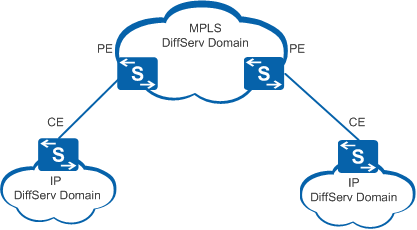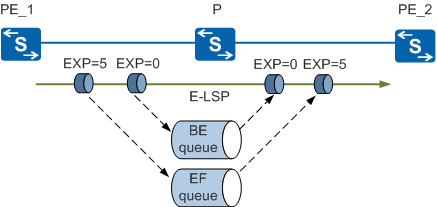MPLS DiffServ
Implementation
In the DiffServ model, network edge nodes map a service to a service class based on QoS requirements. A service class is identified by the differentiated service (DS) field or Type of Service (ToS) field in IP packets or the PRI field (802.1p priority) in VLAN packets. Nodes on a backbone network apply preset policies to the service based on the DS or PRI field to ensure service quality. For details, see Priority Mapping Configuration in the S2720, S5700, and S6700 V200R019C10 Configuration Guide - QoS. The service classification and label distribution mechanisms of DiffServ are similar to MPLS label distribution. MPLS DiffServ combines DS or PRI distribution with MPLS label distribution.
E-LSP
An LSP whose PHB is determined by the EXP field. E-LSP applies to a network with fewer than eight PHBs. A differentiated services code point (DSCP) or 802.1p priority is mapped to a specified EXP value that identifies a PHB. Packets are forwarded based on labels, and the EXP field determines the packet scheduling algorithm and drop priority at each hop. An LSP transmits a maximum of eight PHB flows that are identified by the EXP field in the MPLS packet header. The EXP value can be configured by the Internet service provider (ISP) or mapped from the DSCP or 802.1p priority in a packet. In E-LSP, PHB information does not need to be transmitted by signaling protocols. The label efficiency is high, and its status is easy to maintain.
Table 1 describes the mapping between PHBs and EXP values.
L-LSP
An LSP whose PHB is determined by both the label and EXP value. L-LSP applies to a network with any number of PHBs. During packet forwarding, the label of a packet determines the forwarding path and scheduling algorithm. The EXP field determines the drop priority of the packet. Labels differentiate service flows, so service flows of different types are transmitted over the same LSP. This solution requires more labels and occupies a large number of system resources.

The switch supports only E-LSP.
DiffServ Domain
DiffServ domains include MPLS DiffServ and IP DiffServ domains, as shown in Figure 2.
In the E-LSP solution, MPLS DiffServ manages and schedules packet forwarding between the MPLS and IP DiffServ domains and implements bidirectional mapping between DSCP or 802.1p priorities and EXP values at the MPLS network edge.
Figure 3 illustrates how MPLS DiffServ forwards MPLS packets based on EXP values to provide differentiated services.
When MPLS packets enter the P device, the P device classifies packets and maps EXP values in the packets to CoS values and drop priorities. After traffic classification, QoS implementations include traffic shaping, traffic policing, and congestion avoidance are the same as those on an IP network. When MPLS packets leave the P device, the P device maps CoS values and drop priorities to EXP values. Therefore the downstream device of the P device provides differentiated services based on EXP values.


